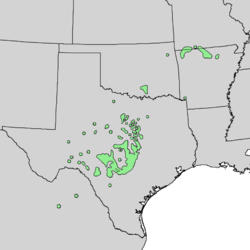Juniperus ashei
| Juniperus ashei | |
|---|---|
 | |
| J. ashei shedding pollen: mature male on right, immature tree on left, mature green females in background | |
| Conservation status | |
| Scientific classification | |
| Kingdom: | Plantae |
| Division: | Pinophyta |
| Class: | Pinopsida |
| Order: | Pinales |
| Family: | Cupressaceae |
| Genus: | Juniperus |
| Species: | J. ashei |
| Binomial name | |
| Juniperus ashei J. Buchholz | |
 | |
| Natural range of Juniperus ashei | |
| Synonyms | |
|
J. sabinoides (H.B.K.) Nees sensu Sargent | |
Juniperus ashei (Ashe Juniper, Post Cedar, Mountain Cedar, or Blueberry Juniper) is a drought-tolerant evergreen tree, native to northeastern Mexico and the south-central United States north to southern Missouri; the largest areas are in central Texas, where extensive stands occur. It grows up to 10 metres (33 ft) tall, rarely 15 metres (49 ft), and provides erosion control and year-round shade for wildlife and livestock.
The feathery foliage grows in dense sprays, bright green in color. The leaves are scale-like, 2 to 5 millimetres (0.079 to 0.197 in) long, and produced on rounded (not flattened) shoots. It is a dioecious species, with separate male and female plants. The seed cones are round, 3 to 5 millimetres (0.12 to 0.20 in) long, and soft, pulpy and berry-like, green at first, maturing purple about 8 months after pollination. They contain 1-2 seeds, which are dispersed when birds eat the cones and pass the seeds in their droppings. The male cones are 3-5 mm long, yellow, turning brown after pollen release in December to February.
Allergy
The pollen causes a severe allergic reaction for some people in the winter, and people who are allergic to Ashe juniper are also often allergic to the related Juniperus virginiana. Consequently, what begins as an allergy in the winter may extend into spring since the pollination of J. virginiana follows that of J. ashei. Ashe juniper is sometimes known in the area as "mountain cedar" (although neither it nor J. virginiana are cedars), and some locals refer to the allergy as cedar fever. Left untreated, symptoms of cedar fever may develop into a more severe infection such as pneumonia. The allergy itself seems to be most prevalent among transplant residents who resided in northeastern states for most of their lives.
Uses
The wood is naturally rot resistant and provides raw material for fence posts. Posts cut from old-growth Ashe junipers have been known to last in the ground for more than 50 years. Over one hundred years ago, most old-growth Ashe junipers were cut and used not only for fence posts, but also for telegraph poles and railroad ties.[2]
Texas
Although Ashe juniper is native to central Texas, it is considered a weed by many landowners and developers in that area, especially by ranchers because overgrazing by cattle selectively removes competition when they avoid the bitter-tasting juniper seedlings. This allows for a high rate of juniper establishment and reduces ranch yields. Ashe juniper does not resprout when cut, like its cousin the redberry juniper.[3]
Overgrazed lands
The junipers that establish in overgrazed lands are young and vigorous, dense and multi-trunked, and shallow rooted. This makes it difficult for remaining grasses to compete for water, especially if they are still being grazed and the soils are impoverished. The presence of these dense, shallow-rooted shrubs also means less water reaches the soil, subsurface flows and deep drainage. However, their dense canopies and thick litter do reduce overland flows compared to grazed grasses. Old-growth Ashe junipers are different in that they have true trunks, use less water, are slow growing, less foliated and have very deep roots. Wilcox (Texas A&M University) and Keith Owens (Texas Ag. Ext. researcher at Uvalde) are currently studying how these deeper roots may facilitate the deep drainage of water down trunk stemflows. Dr. Owens reports that for every one inch of rain, about 6 gallons of previously undocumented water is funneled down the trunks.[4]
References
- ↑ United States Forest Service
- ↑ Bray, William L., 1904. Forest Resources of Texas, U.S. Department of Agriculture, Bureau of Forestry, Bulletin No. 47. Government Printing Office: Washington D.C.
- ↑ McGinty, Allan (18 March 1997). "JUNIPER ECOLOGY". unidentified. Retrieved 2009-01-10.
- ↑ Owens, M.K., R.K. Lyons and C.J. Alejandro. 2006. Rainfall partitioning within semiarid juniper communities: Effects of event size and canopy cover. Hydrological Processes 20:3179-3189.
- Conifer Specialist Group (1998). Juniperus ashei. 2006. IUCN Red List of Threatened Species. IUCN 2006. www.iucnredlist.org. Retrieved on 12 May 2006.
External links
| Wikimedia Commons has media related to Juniperus ashei. |
- Image Archive of Central Texas Plants detailed photographs
- Noble Foundation Plant Image Gallery photographs
- Photograph and dimensions of Texas Champion Ashe juniper
- Evaluation of the Effects of Ashe Juniper (Cedar) Control on Water Quantity, Water Quality, and Suspended-Sediment Loads in three watersheds on the Edwards Aquifer Recharge and Catchment Area, South-Central Texas
